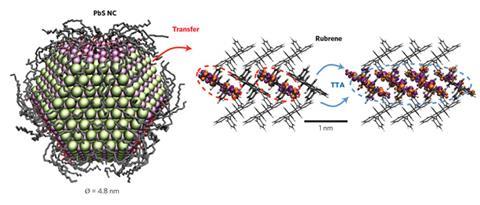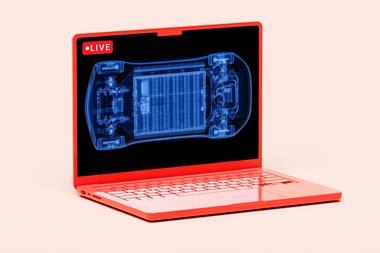Quantum dots could help solar devices break efficiency limit
A new technique for converting infrared photons into visible ones using quantum dots has been demonstrated by researchers in the US. The technique works by a process called triplet–triplet annihilation, and could potentially let semiconductors capture the energy in photons below their bandgap, increasing the energy efficiency of solar cells. It could also, the researchers believe, find applications in biological imaging or infrared cameras.

The efficiency of a single-junction photovoltaic cell is theoretically constrained by the Shockley–Quiesser limit, which dictates that only around 33.7% of the light energy from the sun can be captured as electrical energy. The remainder is lost mainly because p–n junctions can only create excitons with one single energy, which is the difference between the energy of an electron in the semiconductor’s valence and conduction bands. Photons below this energy cannot create an exciton, so they simply pass straight through the active layer. Multi-junction solar cells can capture a greater proportion of the energy, but these are difficult and expensive to produce.
One potential solution is up-conversion, whereby photons with sub-bandgap energies are captured in an organic layer behind the active material and used to create lower-energy triplet excitons. Light cannot directly create triplet excitons efficiently, so a sensitiser is usually added that, when it absorbs a photon, releases a triplet exciton into the organic layer. Two such triplet excitons can then annihilate to create a higher energy singlet exciton, which emits a higher-energy photon back into the active material.
Previous research by inorganic chemist Felix Castellano’s group at North Carolina State University, US, has focused on organometallic sensitisers, which have achieved high efficiencies, but there have been problems. First, the most efficient up-conversion systems have occurred in solution – manufacturing considerations make this undesirable in a commercial solar cell. Secondly, they have so far been unable to up-convert wavelengths longer than 830nm, which would severely limit their use in solar cells.
Successful annihilation
In the new research, Mark Wilson and colleagues at the Massachusetts Institute of Technology used a solid state structure comprising an 80nm-thick layer of the sensitiser rubrene doped with dibenzotetraphenylperiflanthene, covered with lead sulfide quantum dots with absorption peaks at 850nm, 960nm or 1010nm. The researchers then excited the layer with an 808nm laser and found that it glowed in the visible spectrum. They concluded that this showed that the quantum dots had excited triplet excitons in the rubrene, and these had annihilated successfully.
Castellano is cautiously impressed: ‘It’s a beautiful example for a proof-of-concept that you can do near-infrared to visible up-conversion using semiconductor nanomaterials interfaced with molecules,’ he says. The challenge, he believes, will be to ensure that triplet excitons can move through the solid material quickly enough to meet other triplet excitons and annihilate before they simply decay to heat. At present, only about 1% of excited states in the quantum dot actually make it through to be emitted as up-converted photons – although the researchers are working to optimise this.
Organic solid state chemist Gerhard Wegner of the Max Planck Institute for Polymer Research in Germany says that, until the details of how excitons are transferred from a sensitiser to an annihilator are worked out, the low efficiency is likely to remain a stumbling block. ‘I expect that, if a breakthrough comes, it will come from theory.’
Wilson accepts the need to maximise efficiency before the technique can meaningfully contribute to photovoltaics, but he believes that, before then, the technology could be useful for simply detecting light. Self-driving cars, for example, usually use infrared cameras as they see better in the dark or in fog. ‘If we can get this to the performance where we can use a $10 (£6.6) iPhone camera instead of a $20,000 camera from a missile that really makes a difference to the price of an automobile,’ he says.
References
M Wu et al, Nat. Photon., 2015, DOI: 10.1038/nphoton.2015.226












No comments yet